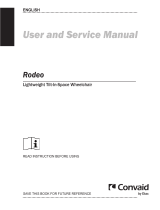
05
SPEX CUSHION USER MANUAL 4WWW.SPEXSEATING.COM
RISK OF ACCIDENT, INJURY, PAIN OR DEATH IF WARNINGS ARE NOT HEEDED
Seek assistance if you are uncertain about any of the following points
1. Installing a Cushion on a wheelchair may disturb the wheelchair’s centre of gravity and cause
the wheelchair to tip backwards potentially resulting in injury or death. Check if anti-tippers or
other adaptations need to be added to the wheelchair to help increase stability.
2. Installation and adjustment of your Spex Cushion must only be performed by
a) An authorized Spex distributor or technician
b) A qualied healthcare professional who has undergone appropriate biomechanical training
3. The Spex Cushion must have a solid base to install to. A solid seat base pan will provide more
stability to the user (the Cushion won’t sag).
4. This Cushion must be trialled rst to determine its eectiveness in meeting the needs of the user.
The clinician must inspect the user’s skin to ensure that red pressure spots are not developing.
5. The user and/or caregivers should regularly check for skin redness or tissue breakdown. If
redness develops, discontinue the use of the Cushion immediately and consult your doctor or
therapist. The Cushion can be recongured for better positioning.
6. With proper set-up and continued maintenance, the Spex Cushion is an excellent candidate
for people who are at risk of skin ulcers, however no Cushion can completely eliminate sitting
pressure or prevent pressure ulcers.
7. Keep the Cushion dry. Moisture is a contributing factor in causing pressure ulcers.
8. We recommend the user to have a good diet and have regular pressure relieving exercises/
therapy to help prevent pressure ulcers.
9. Do not leave the Spex Cushion outside overnight or at temperatures below 5° C/41° F. The Spex
Cushion should be room temperature before sitting on it.
10. Avoid sharp objects or exposure to excessive heat or open ame.
11. The Spex Cushion has been specically designed as a Cushion for users in mobility wheelchairs.
Do not use the Cushion in any way not described and never modify the Cushion.
12. Never use the Cushion without its cover. Care should be exercised near open ame or burning
cigarettes. Using the Cushion without its cover increases the risk of ammability and skin
damage.
13. Never use the Cushion without the incontinence cover. Failure to do so will reduce the life of
the Cushion.
WARNING
Compatibility
• The Spex Cushion has been designed to be compatible with most wheelchairs.
• The Spex Cushion must have a solid base to install to, such as a solid seat base pan or cushion rigidiz-
er, which provides more stability to the user.
























